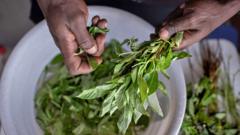Can Kenya's Overlooked Weeds Become the Next Culinary Sensation?

Rediscovering Indigenous Leafy Vegetables in Kenya
Once overlooked, indigenous leafy vegetables in Kenya are witnessing a resurgence in popularity. These once-dismissed greens, locally known as "kienyeji," are now celebrated for their nutritional benefits and flavor. Farmers are cultivating them, markets are bustling with their sales, and restaurants are proudly including them on their menus. The shift in attitude towards these native plants marks an important cultural and nutritional evolution in the region.
At Skinners Restaurant in Gachie, just outside Nairobi, the demand for kienyeji exceeds that of other greens. Kimani Ng'ang'a, a restaurant employee, notes that diners specifically request these local varieties, despite the fact that they come at a premium price due to their limited availability. This reflects a growing trend among Kenyans who are increasingly aware of the health benefits associated with consuming locally sourced, organic vegetables.
Traditional vegetables like cabbage, spinach, and kale—introduced by colonial authorities—remain popular for their affordability and accessibility. However, the interest in kienyeji is on the rise as more people recognize their health benefits. "It detoxifies the body and is good in weight loss," says James Wathiru, a customer who ordered "managu," or African nightshade. Others echo similar sentiments, emphasizing the superior taste of these indigenous varieties.
The Nutritional Value of Indigenous Leafy Vegetables
Horticulture professor Mary Abukutsa-Onyango highlights that this growing preference is backed by scientific research. Over the last decade, production of local greens has doubled, with local farmers producing 300,000 tonnes last year. Indigenous vegetables are not only richer in essential minerals than their imported counterparts, but they also boast higher levels of vitamins A and C, along with antioxidants that enhance immunity and reduce disease risks.
For instance, 100 grams of mrenda (jute mallow) contains more nutrients than the same portion of common cabbage. This nutritional richness has led to a significant shift in perception. Once regarded as "weeds," these vegetables are now celebrated for their resilience to diseases and pests, allowing them to be grown organically without the need for harmful chemicals.
Cultural Recognition and Preservation Efforts
The shift towards embracing indigenous vegetables has not gone unnoticed. In 2021, UNESCO acknowledged Kenya's efforts to safeguard its intangible cultural heritage, which includes the promotion of traditional foods. Since 2007, a project involving scientists and local communities has been documenting traditional foods, leading to an inventory of 850 indigenous plants and their local names.
While some indigenous vegetables like sukumawiki (commonly known as "kale") are still widely favored—over 700,000 tonnes produced in 2023—others are gaining popularity. Farmers like Francis Ngiri, who have transitioned to organic farming, are pivotal in this movement. Ngiri moved to Kenya's Rift Valley to cultivate 14 native varieties in 2016, which has since expanded to 124 varieties. His farm serves as a model for regenerating forgotten plants and ensuring their genetic diversity.
The Challenges of Seed Exchange and Regulation
Despite the enthusiasm surrounding indigenous crops, challenges persist. Current regulations prohibit the exchange and sale of uncertified seeds, which hampers the efforts of farmers like Ngiri who wish to preserve these varieties. Policies intended to protect farmers from poor-quality seeds inadvertently threaten the survival of traditional crops. Wambui Wakahiu, who trains farmers in seed conservation, emphasizes that these laws contribute to the extinction of over 35 traditional plant varieties in just one county.
Advocates for indigenous crops argue that these regulations conflict with international treaties that uphold farmers' rights to save, use, and exchange seeds. Efforts are underway to align Kenyan laws with these agreements, allowing for the legal exchange of seeds without fear of penalty. However, the sale of these seeds will still be outlawed, presenting ongoing challenges for advocates of indigenous agriculture.
The Popularity of Indigenous Greens in Markets
As the popularity of indigenous greens rises, vendors in local markets are noticing a shift in consumer preferences. Priscilla Njeri, a vegetable vendor in the Wangige market, observes that her customers increasingly favor indigenous vegetables like managu, terere, and kanzira (African kale). She attributes this trend to media campaigns promoting the health benefits of these greens, underscoring the importance of community awareness and education in driving demand.
Indigenous vegetables are not just a trend; they represent a return to local food systems that prioritize health, biodiversity, and cultural heritage. As demand continues to grow, it opens doors for farmers, researchers, and consumers alike to engage with and promote these nutrient-rich crops.
Conclusion: A Nutritional and Cultural Renaissance
The renaissance of indigenous leafy vegetables in Kenya symbolizes more than just a dietary preference; it embodies a broader cultural revival. As more Kenyans embrace these local greens, they contribute to a sustainable food system that respects tradition while addressing modern health challenges. The journey to reclaim the nutritional and cultural value of indigenous crops is ongoing, but the momentum is undeniable.
As we look ahead, fostering a greater understanding of indigenous vegetables could pave the way for a healthier future. How can communities continue to champion the cultivation and consumption of these nutrient-rich foods? What role does local cuisine play in promoting health and sustainability?
FAQs
What are kienyeji vegetables?
Kienyeji vegetables refer to indigenous leafy greens in Kenya that are traditionally grown and consumed. They include varieties like managu (African nightshade), terere (amaranth), and mrenda (jute mallow), which are known for their nutritional benefits.
Why are indigenous vegetables becoming popular in Kenya?
The popularity of indigenous vegetables is increasing due to their health benefits, better taste, and growing awareness of the importance of organic farming. Additionally, media campaigns are helping to raise awareness about these nutrient-rich foods.
What challenges do farmers face in growing indigenous crops?
Farmers face regulatory challenges that prohibit the exchange and sale of uncertified seeds, which hinders the preservation of traditional crops. This is compounded by the historical focus on exotic crops that often dominate the market.
As the conversation around indigenous leafy vegetables continues to develop, embracing these local crops could redefine the future of Kenyan cuisine and agriculture. #IndigenousVegetables #Kienyeji #KenyanCuisine
```Published: 2025-07-21 01:27:07 | Category: world



